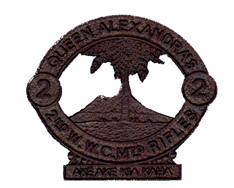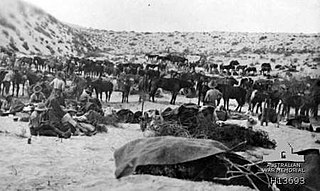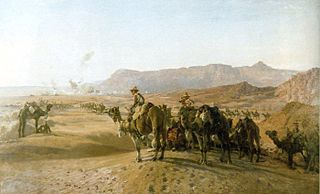The Australian Mounted Division originally formed as the Imperial Mounted Division in January 1917, was a mounted infantry, light horse and yeomanry division. The division was formed in Egypt, and along with the Anzac Mounted Division formed part of Desert Column, Egyptian Expeditionary Force in World War I. The division was originally made up of the Australian 3rd Light Horse Brigade, the reconstituted 4th Light Horse Brigade, and two British yeomanry brigades; the 5th Mounted Brigade and 6th Mounted Brigade.

The New Zealand Expeditionary Force (NZEF) was the title of the military forces sent from New Zealand to fight alongside other British Empire and Dominion troops during World War I (1914–1918) and World War II (1939–1945). Ultimately, the NZEF of World War I became known as the First New Zealand Expeditionary Force. The NZEF of World War II was known as the Second New Zealand Expeditionary Force (2NZEF).

Queen Alexandra's Mounted Rifles (QAMR) is an armoured regiment of the New Zealand Army and forms part of the Royal New Zealand Armoured Corps. The Regiment was formed in 1864 and is currently an armoured cavalry unit equipped with NZLAV.
The 3rd Battalion, Auckland and Northland Regiment is a Territorial Force Battalion of the New Zealand Army, with Headquarters in Arch Hill Auckland Army Centre. The unit consists of Company sized units which have their headquarters in Auckland and Whangarei. The unit is part of Training and Doctrine Command (TRADOC) headquartered at Waiouru.
The Royal East Kent Yeomanry was a British Army regiment formed in 1794. It saw action in the Second Boer War and the First World War.

The Queen Alexandra's 2nd Mounted Rifles was formed on March 17, 1911. They were mobilised during the Great War as a squadron of the Wellington Mounted Rifles Regiment. They served in the Middle Eastern theatre of World War I and first saw action during the Battle of Gallipoli. As a part of the larger New Zealand Mounted Rifles Brigade they went on to serve in the Sinai and Palestine Campaign.

The 3rd (Auckland) Mounted Rifles was formed on March 17, 1911. They were mobilised during the First World War as a squadron of the Auckland Mounted Rifles Regiment. They served in the Middle Eastern theatre of World War I and first saw action during the Battle of Gallipoli. As a part of the larger New Zealand Mounted Rifles Brigade they went on to serve in the Sinai and Palestine Campaign.
The 5th Mounted Rifles was formed on 17 March 1911. It formed part of the Otago Mounted Rifles Regiment so they saw service during the Battle of Gallipoli, Egypt. They later served in France with the New Zealand Division and were the only New Zealand Mounted troops to serve in France.

The 6th (Manawatu) Mounted Rifles was formed on March 17, 1911. They were mobilised during World War I as a squadron of the Wellington Mounted Rifles Regiment. They served in the Middle Eastern theatre of World War I and first saw action during the Battle of Gallipoli. As a part of the larger New Zealand Mounted Rifles Brigade, they went on to serve in the Sinai and Palestine Campaign.

The 8th Mounted Rifles was formed on March 17, 1911. They were mobilised during World War I as a squadron of the Canterbury Mounted Rifles Regiment. They served in the Middle Eastern theatre of World War I and first saw action during the Battle of Gallipoli. As a part of the larger New Zealand Mounted Rifles Brigade they went on to serve in the Sinai and Palestine Campaign.

The 9th Mounted Rifles was formed on March 17, 1911. They were mobilised during World War I as a squadron of the Wellington Mounted Rifles Regiment. They served in the Middle Eastern theatre of World War I and first saw action during the Battle of Gallipoli. As a part of the larger New Zealand Mounted Rifles Brigade they went on to serve in the Sinai and Palestine Campaign.

The 10th (Nelson) Mounted Rifles, previously known as the 1st Regiment, Nelson Mounted Rifles is a military unit based in Nelson, New Zealand. They served in the Middle Eastern theatre of World War I and first saw action during the Battle of Gallipoli. As a part of the larger New Zealand Mounted Rifles Brigade they went on to serve in the Sinai and Palestine Campaign.

The 11th Mounted Rifles was formed on 17 March 1911. They were mobilised during World War I as a squadron of the Auckland Mounted Rifles Regiment. They served in the Middle Eastern theatre of World War I and first saw action during the Battle of Gallipoli. As a part of the larger New Zealand Mounted Rifles Brigade they went on to serve in the Sinai and Palestine Campaign.
The 12th (Otago) Mounted Rifles was formed 17 March 1911. During World War I they formed part of the Otago Mounted Rifles Regiment and saw service during the Battle of Gallipoli, afterwards they were withdrawn to Egypt and later were the only New Zealand Mounted troops to serve in France with the New Zealand Division.

The 3rd Light Horse Regiment was a mounted infantry regiment of the Australian Army during the First World War. The regiment was raised in September 1914, and by December as part of the 1st Light Horse Brigade had moved overseas. The regiment only fought against the forces of the Ottoman Empire, in Egypt, at Gallipoli, on the Sinai Peninsula, and in Palestine and Jordan. After the armistice the regiment eventually returned to Australia in March 1919. For its role in the war the regiment was awarded nineteen battle honours.

The 4th Light Horse Regiment was a mounted infantry regiment of the Australian Army during the First World War. The regiment was raised in August 1914, as the divisional cavalry regiment for the 1st Division. The regiment fought against the forces of the German Empire and the Ottoman Empire, in Egypt, at Gallipoli, on the Western front, on the Sinai Peninsula, and in Palestine and Jordan. After the armistice the regiment eventually returned to Australia in March 1919. For its role in the war the regiment was awarded twenty-one battle honours.

The 6th Light Horse Regiment was a mounted infantry regiment of the Australian Army during the First World War. The regiment was raised in September 1914, and assigned to the 2nd Light Horse Brigade. The regiment fought against the forces of the German Empire and the Ottoman Empire, in Egypt, at Gallipoli, on the Sinai Peninsula, and in Palestine and Jordan. After the armistice the regiment eventually returned to Australia in March 1919. For its role in the war the regiment was awarded sixteen battle honours. During the inter-war years, the regiment was re-raised as a part-time unit based in New South Wales, adopting the designation of the "New South Wales Mounted Rifles". It was later converted to a motor regiment during the early years of the Second World War before being redesignated as an armoured car regiment. Nevertheless, it was disbanded in early 1943 without having been deployed overseas. During the post war years, the regiment was re-raised as part of the Citizens Military Force, and in 1956 was converted into an infantry unit, and in 1960 was subsumed into the Royal New South Wales Regiment.

Brigadier General William Meldrum was a New Zealand lawyer, farmer, military leader, magistrate and local politician.














